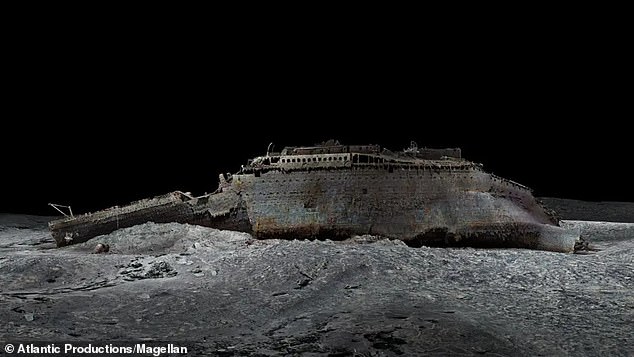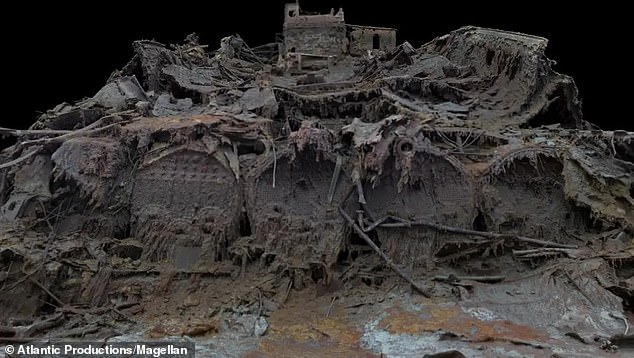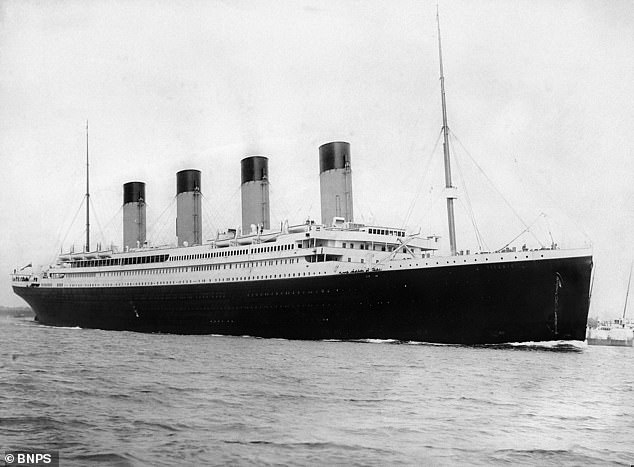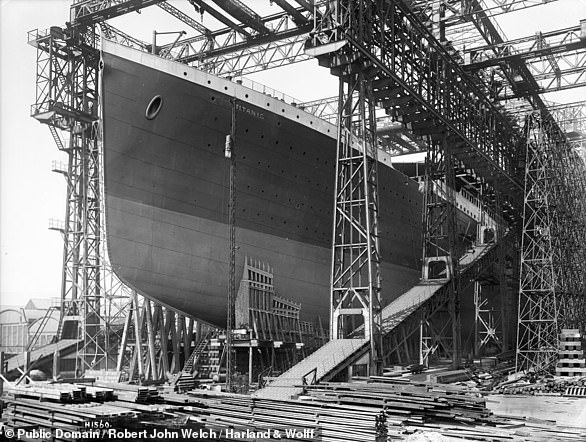The sinking of history’s most tragic ship – the Titanic – could have been caused by just a six second collision and gashes the size of an A4 sheet of paper, shocking new research has revealed.
It has been more than a century since the ‘unsinkable’ ocean liner plunged to the depths of the Atlantic Ocean, leaving more than 1,500 dead.
And now stunning images have revealed for the first time its demise in groundbreaking detail.
Experts at deep-sea mapping company Magellan Ltd have snapped the wrecked luxury liner from new angles about 12,500 feet below the ocean’s surface.
According to research leader Jeom-Kee Paik at University College London, they show the Titanic only made a glancing blow against the iceberg.
But it was left with devastating punctures the size of A4 pieces of paper spread across six compartments along a narrow section of the hull.
‘Those small holes are across a long length of the ship,’ Simon Benson, naval architect at the University of Newcastle, told the BBC.

Experts at deep-sea mapping company Magellan Ltd have snapped the wrecked luxury liner from new angles about 12,500 feet below ocean surface. Pictured, the bow (front of the ship)

The images, published by the BBC, reveal a new view of the boiler room near where the liner split in two. Some of the boilers (pictured) are concave (they curve inwards), which suggests they were still operating as they were plunged into the icy water

The grandest ship: RMS Titanic departing on its maiden voyage from Southampton on April 10, 1912. The remains now lie on the seafloor about 350 nautical miles off the coast of Newfoundland, Canada
‘So the flood water comes in slowly but surely into all of those holes, and then eventually the compartments are flooded over the top and the Titanic sinks.’
The digital scans reveal a new view of the boiler room near where the liner split in two.
Some of the boilers are concave, which suggests they were still operating as they were plunged into the icy water.
Meanwhile, punctures in the hull ‘the size of A4 pieces of paper’ caused the ship’s speedy demise – just two hours and 40 minutes after it hit the iceberg.
‘Titanic is the last surviving eyewitness to the disaster, and she still has stories to tell,’ Titanic analyst Parks Stephenson told the BBC.
‘Having a comprehensive view of the entirety of the wreck site is key to understanding what happened here.’
Also revealed by the scans is a valve in an open position, indicating that steam was still flowing into Titanic’s electricity generating system.
This backs up eyewitness reports from the fateful night that a team of brave engineers worked right to the end to keep the ship’s lights on.

Pictured, the heavily-damaged stern of the ship (the rear or aft-most part of the vessel) which slammed into the sea bed so hard it distorted its shape

Also revealed by the scans is a valve in an open position, indicating that steam was still flowing into Titanic’s electricity generating system

Hero: A team led by Cumbria-born engineer Joseph Bell (pictured) worked to shovel coal into the furnaces to keep Titanic’s lights on as it sank
The team, led by Cumbria-born engineer Joseph Bell, worked to shovel coal into the furnaces to keep the lights on.
All died in the disaster, but their heroic actions saved many lives by giving crew time to launch the lifeboats safely, Mr Stephenson told the BBC.
‘They held the chaos at bay as long as possible, and all of that was kind of symbolised by this open steam valve just sitting there on the stern,’ he said.
The scans have been studied for a new documentary by National Geographic and Atlantic Productions called ‘Titanic: The Digital Resurrection’.
It follows the first batch of digital scans images from Magellan Ltd released two years ago that revealed the 3D reconstruction of the wreck.
Magellan Ltd sent submersibles to survey all parts of the wreck, which lies around 13,000 feet under the water’s surface.
As well as the imagery, a new simulation reconstructs RMS Titanic and the damage caused that tragic night nearly 113 years ago exactly.
RMS Titanic – owned and operated by British company White Star Line – tragically sank in the early hours of April 15, 1912 after a collision with an iceberg in the Atlantic Ocean, killing an estimated 1,517 of the 2,224 people on board.
The remains now lie on the seafloor about 350 nautical miles off the coast of Newfoundland, Canada.
However, the delicate wreck is deteriorating so rapidly underwater that it could disappear completely within the next 40 years.

This image released in 2023 shows stalactites of rust on the ship’s bow, the serial number on a propeller, and a hole over where the grand staircase once stood

This 2023 image shows the stern (the back of the ship) as a twisted mess of metal, after it hit the ocean floor still rotating in a counter-clockwise direction
Titanic broke in half just before it made its final plunge in the early hours of April 15, 1912, and now two parts of the ship – the bow and the stern – lie 2,600 feet apart.
Titanic’s stern (the back of the ship) is a twisted mess of metal after it hit the ocean floor still rotating in a counter-clockwise direction.
The V-shaped bow is more recognisable, complete with railings, although much of it is buried under mud due to the force of impact.
Both halves are surrounded by a field of debris consisting of bits of metal, pieces of furniture, unopened champagne bottles and even passengers’ shoes.
The wreck wasn’t located until September 1, 1985 – a discovery that made global headlines.







